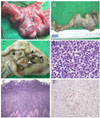Lymphomatous polyposis (LP) is a distinct clinicopathologic condition; it has been described as an unusual form of lymphoma that manifests with numerous polyps that affect long segments of the gastrointestinal tract in human [2,9]. Isaacson et al. definitively distinguished LP from other primary gastrointestinal lymphomas because of its poor prognosis; he suggested that LP was the intestinal counterpart of nodal mantle zone lymphoma [3]. Lavergne et al. [7] confirmed that LP consisted of a mantle-cell B-cell phenotype with a nodular and monotonous growth pattern of small-cleaved cells. Multiple lymphomatous polyposis is a distinctive and particularly rare clinical type of malignant gastrointestinal lymphoma, which is classified as B-cell centrocytic non-Hodgkin's lymphoma. This rare entity has been recently reclassified as mantle cell lymphoma [6].
Canine malignant lymphoma is one of the most common tumors and there are 2 anatomic forms of this disease that predominate in dogs: multicentric and alimentary. Gastrointestinal lymphoma accounts for approximately 5-7% of all canine lymphomas [8]. Canine primary gastrointestinal lymphoma typically does not affect the superficial lymph nodes or the spleen, unlike the multicentric form in which these organs are almost always involved. The majority of canine gastrointestinal lymphomas appear to be primary, with most cases being reported in the small intestine and less cases have been reported in the stomach; only a few cases have been in the colon [1,5]. Identifying the lymphoma immunophenotype can be useful for the treatment and prognosis because it affects both the selected therapy and the outcome. Thus, the origin of the cell type is an important factor that affects the prognosis of primary canine gastrointestinal lymphoma [1]. In this study, in order to evaluate the abnormality of the intestines, we examined the neoplastic tissue by performing gross and histopathological analysis.
A male 5-year-old Jindo dog underwent an enterectomy and enteroanastomosis due to ileus of the intestine at a local veterinary hospital. The excised intestine was presented to the pathological laboratory at the College of Veterinary Medicine, Kyungpook National University to evaluate for intestinal abnormality. For the dog's clinical history, there was enterectomy and enteroanastomosis performed in the upper intestine 6 months before, and the dog had recently suffered from the progressive anorexia, depression, emaciation and hypoalbuminemia (2.3 mg/dl) for 15 days. The length of the excised intestine was about 30 cm during enterctomy (Fig. 1A). The excised intestine was markedly thickened due to multinodular masses in the serosal layer of the upper part, and there was also an irregularly thickened wall (Fig. 1B). Soft-to-firm, cream-colored neoplastic nodules typically showed extensive nodular mucosal protuberances into the lumen (Fig. 1C). Moreover, in the lower part of the intestines, the mucosal layer was hemorrhagic and it showed a congested mucosal membrane.
The excised tissue was immediately fixed in 10% neutral buffered formalin for light microscopy. Under a microscope, the mass lesions of the upper intestine were similar to the other nodules. The neoplastic masses of the serosal and mucosal layers were occupied with diffuse large round cells. The neoplastic cells were round and ovoid in shape, and they had pale and/or hyperchromatic nuclei of various sizes with small nucleoli (Fig. 1D). Mitotic figures were frequently observed (3 to 5 per high-power field). The neoplastic cells were infiltrated mainly into the mucosa and submucosa, and they had diffusely invaded into the muscular and serosal layer (Fig. 1E). Additionally, it could be seen that large neoplastic lymphocytes had diffusely invaded the lower part of the surgically excised intestine. To identify the cell origin of the neoplastic lymphocytes, consecutive sections were stained immunohistochemically with using the avidinbiotin-peroxidase complex method (Vectastain ABC kit; Vector, USA). The primary antibodies we used included monoclonal CD20 antibody (1 : 300; DakoCytomation, USA) as the B-cell marker and CD3 (1 : 300; NeoMarkers, USA) as the T lymphocytes marker. On the immunohistochemical results, the tumor cells were diffusely positive for CD20 (Fig. 1F), but they were negative for CD3.
Immunohistochemically, we used human CD20 antibodies against canine B cells in order to examine the origin of tumorous lymphocytes. CD20 is a tetraspanning transmembrane phospho-protein that is predominantly expressed in pre-B cells and mature peripheral B cells in both humans and mice. In addition, CD20 is among the first molecules that have been successfully used as immunotherapeutic targets [10]. In humans, CD20 is also strongly and homogeneously expressed in most mature B-cell malignancies, except for chronic lymphocytic leukemia cells where the expression varies. The function of CD20 is not fully understood, although it appears to be important in terms of receptor-induced calcium signals. The engagement of CD20 with using antibodies leads to an increase in intracellular calcium in human B cells, and CD20-deficient mice show compromised calcium mobilization upon engagement of CD19 [4]. Our results showed that an antibody that recognizes intracellular domains binds to a canine CD20 homolog and so it is suitable for use as a part of a panel to identify normal and malignant canine B cells for routine diagnostic purposes. However, specific antibodies directed against canine CD20 extracellular domains will be required and these molecules can be explored in dog models since none of the antibodies directed against the extracellular domains bind canine CD20.
In conclusion, the intestinal masses typically showed extensive nodular mucosal protuberances into the lumen and they consisted of diffusely neoplastic lymphocytes. Therefore, the morphological diagnosis determined that the dog had multiple intestinal malignant lymphomatous polyposis. Based on the immunohistochemistry, the tumor cells were of a B-cell origin since the tumor cells positively expressed anti-CD20 antibody. Herein, we are the first to report on a case of multiple lymphomatous polyposis from the Jindo dog. Moreover, this report presents the need for understanding the origin of tumor cells for creating canine specific antibodies. It is hoped that this will be a topic for future investigation.




 PDF
PDF ePub
ePub Citation
Citation Print
Print



 XML Download
XML Download